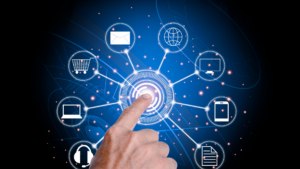A security system is only as good as the weakest link. Think of it like the lock on your front door; it can be picked by a thief. But what if you don’t need a key or combination to open your door? What if your door opened based on a camera view of your face or a finger print? Welcome to biometrics. This frontier security technology can be applied to cyber security, where it uses unique physical characteristics (like fingerprints, facial features, and voice patterns) to identify individuals.
With identity theft on the rise1, biometrics identification has become increasingly more popular within security architectures. By using a person’s unique physical and behavioral traits, biometrics can identify them more accurately than passwords alone can. Providing more effective protection against cyber-attacks.
Biometrics as a security measure is not a new concept. The military and law enforcement have been using fingerprint identification for decades. But the technology has only recently become available to the general public. Commercial biometric systems are now being used to control access to buildings, computer networks, and even bank accounts.
How does biometrics work?
When a person needs access to a secure area, system or device they are required to input their unique physical characteristics. This scan of their face, fingerprint or voice analysis is then compared to the identity information stored within the biometric system. If the scan matches the database, the person is allowed access. If not, their access is denied even if any accompanying identification information is correct (such as a user name and password).
What are Examples of Common Biometric Security Systems?
Biometric security systems have a wide range of applications. Some of the more common biometric security systems include:
Fingerprint Identification
- This is probably the best-known and most widely used biometric security system. Fingerprint identification uses the patterns on your fingers to identify you. It is used in everything from passports to laptop computers.
Facial Recognition
- This system uses digital cameras to capture images of a person’s face. The images are then analyzed for features that can be used to identify the individual. Facial recognition is used in security systems at airports and other high-security areas.
Voice recognition
- This system uses a person’s voice to identify them. It is used in telephone banking and other secure applications.
Iris Scanning
- This system uses the patterns in a person’s irises to identify them. Iris scanning is used for security purposes in some countries, such as Dubai, where it is was first introduced. These scans are used to identify people who may otherwise need to have a special identity card such as a passport.
What are the benefits of biometrics?
The benefits of biometrics are vast and include many attributes that contribute to a much more secure environment.
Here is a list of the top 10 benefits associated with biometrics:
- Biometric systems are very secure.
- Biometric systems are some of the most secure on the planet. They are difficult to pick or crack and are not susceptible to social engineering.
- Biometric systems are convenient.
- Users don’t have to remember any passwords or PINs. They just scan their finger, face, or voice, and they’re in. This offers a much more convenient and efficient alternative to traditional security measures like passwords and PINs.
- Biometric systems are tamper-proof.
- Once a person’s biometric information has been stored in a system, it cannot be changed or altered in any way. This makes it nearly impossible for anyone to gain unauthorized access to a secure area or facility.
- Biometric systems are accurate.
- Fingerprints, for example, are very difficult to forge, and most systems can identify an individual with 99.9% accuracy.
- Biometric systems are easy to use.
- Most biometric systems are very user-friendly and can be operated by anyone, regardless of their level of computer literacy.
- Biometric systems are cost-effective.
- Cards and fobs are prone to getting lost, which involves replacement cost, whereas biometrics are never lost. Further, biometric systems are automated and do not need dedicated security staff, resulting in cost savings associated with hiring security employees.
- Biometric systems are scalable.
- This means that they can be used in a wide variety of applications, from controlling access to a single building or facility to managing the security of an entire city.
- Biometric systems are evolving.
- Technology is constantly evolving and becoming more sophisticated. This means that the systems will become increasingly reliable and user-friendly in the years to come.
- Biometric systems are environmentally friendly.
- Traditional security measures, like ID cards and passwords, require paper and other resources that can be harmful to the environment. Biometric systems do not rely on any physical documentation and are thus much more environmentally friendly.
- Biometric systems are compliant with regulations.
- Most biometric systems are compliant with various international and national regulations governing data security and privacy. This ensures that businesses and organizations can use them without any legal implications.
Of course, there are more benefits to using biometric security systems but these are some of the most important. They offer a more secure, efficient, a convenient alternative to traditional security measures and are suitable for a wide range of applications.
It is however important to understand that while utilizing biometric technology, there should be a balance between security and protection of privacy. CSIS (Center for Strategic & International Studies) has assembled a list of valuable information and websites2 to help in the use of biometric technology.
So why is biometrics a more effective form of security than passwords?
Biometric systems are much harder to steal or fake than passwords. Attackers can get passwords through a variety of methods, such as; phishing and social engineering, malware brute forcing, guesswork, shoulder surfing, etc. But biometric information cannot be used by attacks to gain access because each person’s physical characteristics are unique and cannot be copied or faked.
Biometrics is quickly becoming one of the most effective forms of cybersecurity because it is fast evolving and reliable. Biometric systems can also provide a more secure environment for your confidential data as it is not reliant on any physical documentation like passwords or ID cards. For these reasons, biometrics will become the standard form of security moving forward.
Protect yourself with biometric solutions from Aurora and our parent company Plurilock.
Aurora is a global leader in biometric security solutions. We offer a wide range of products that use biometric technology to protect your data and secure your facilities. For more information on our behavioral biometric solutions, please visit or contact us at sales@aurorait.com.
Plurilock DEFENDTM detects compromised sessions and credentials in real time using behavioral biometrics. To learn more and schedule a demo.
Sources:



